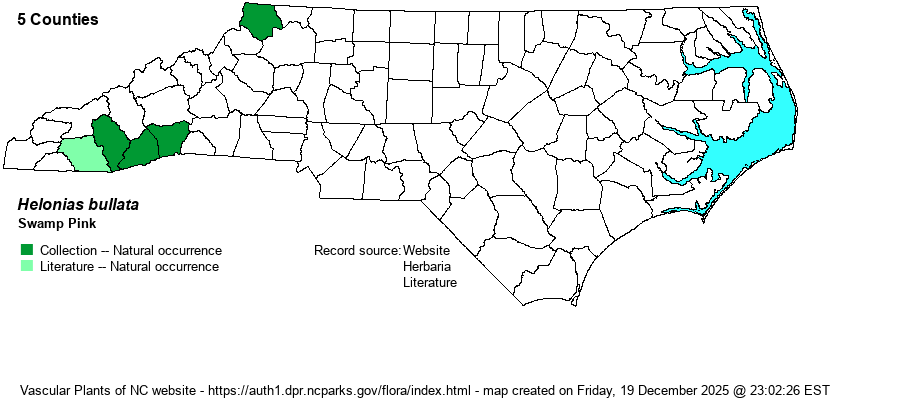| Author | L. | |
| Distribution | Found primarily in the southwestern portion of the Mountains, from Henderson County west to Macon County. Also known from a single site in the northern Mountains in Ashe County.
This is a globally rare species, found only in a narrow zone from southern NY (historical), NJ, DE, and MD south into VA and western NC, northwestern SC, and northeastern GA. It does not occur in TN, KY, or WV. It is disjunct from the Mountains of GA to VA and WV, to the Coastal Plain of NJ, DE, and MD.
| |
| Abundance | Very rare and local in the southern Mountains, and extremely rare in the northern Mountains. Not only is this a State listed species (Threatened), it is also Federally listed as Threatened, as well. Its Global Rank is G3, with the primary area of abundance in the Pine Barrens region of southern NJ. | |
| Habitat | In NC this species is essentially limited to bogs, especially close to or under shrubs, in peat-based soils. It seems to prefer some light shade as opposed to growing in the more open parts of the bogs. |
| Phenology | Blooms in April and May, and fruits in June and July. | |
| Identification | This is a monotypic genus and no other species even remotely looks like Swamp Pink. It has evergreen, long and fleshy leaves in a basal rosette. The handful of leaves are oblanceolate and about 6-7 inches long and about 1.5 inches wide. Often the species can be identified just from the leaves, but the flowering stalk ends any guesswork. It is a naked stalk about 8-9 inches tall, topped by a flower cluster about 2 inches tall and 1 inch wide. The many dozens of small bright pink flowers are so dense that you can barely see the details of the tepals and the reproductive parts. To see this spectacular and unusual wildflower you will need to visit a known site, though as it is so rare, and possibly vulnerable to poaching, that locations are usually withheld from the public. Thankfully, most locations seem to exist now in protected sites. | |
| Taxonomic Comments | None, other than it is the sole member of its genus. Though it exists in the amily Heloniadaceae, Weakley (2018) states that this family has two other genera (besides Helonias), and a total of 15 species in eastern North America (1) and eastern Asia (14).
| |
| Other Common Name(s) | None | |
| State Rank | S2 | |
| Global Rank | G3 | |
| State Status | T | |
| US Status | LT | |
| USACE-agcp | OBL link |
| USACE-emp | OBL link |

